|
K2UYH Moonbounce WAC [1976]
Success! Years of
dedicated work climaxed in a two and one-half second trip to the moon and
back. For K2UYH his final continent garnered via the joint efforts of
fellow amateurs.
By James M. Morris, KH6HQG
(Editorial Assistant, QST)
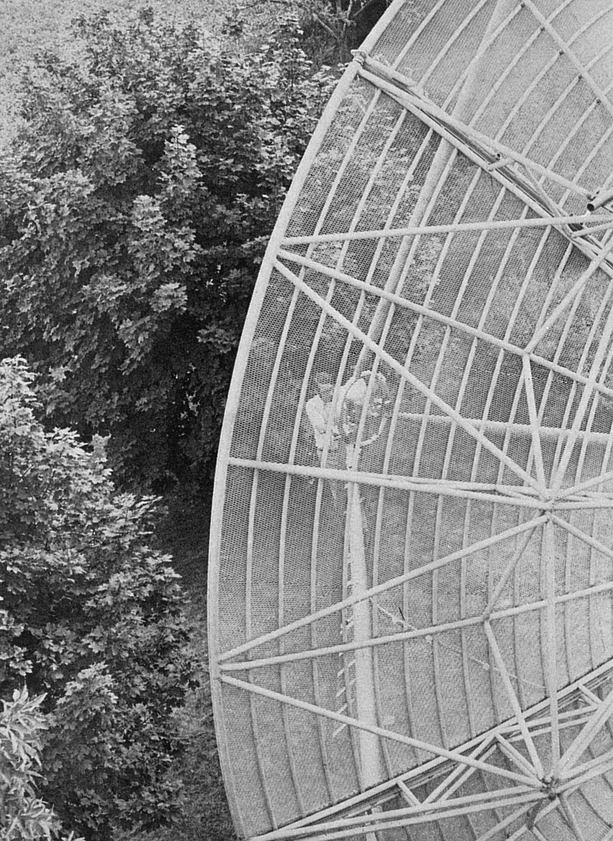
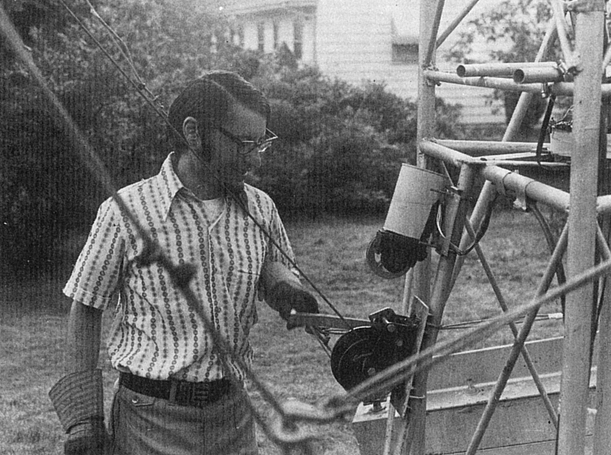
|
In
preparation for maintenance work, he makes it look easy to bring the
multi-ton structure to the horizon. |
|
All the elements
of drama and adventure - international diplomacy, pioneering records,
foreign expeditions, personal achievement - came alive in the week-long
operation which climaxed on July 29, 1976, in the first Worked All
Continents on 432 MHz and EME (earth-moon-earth) by Allen Katz, K2UYH. For
Katz, the HK1TL (Tiere Luna) contact realized his “impossible dream.”
When moonbounce
work started in the early sixties, only a handful of radio amateurs tried,
and fewer succeeded, because of the tremendous diminishing of signal
strength. At 432 MHz, a reflected signal is only a miniscule fraction as
strong as when it was originally transmitted. In EME circles this
phenomenon is called path-loss obstacle. But with extremely high-gain
antennas, efficient feed lines and amateur persistence, the radio art kept
advancing until effective systems became readily available. After the
latest series of National Radio Laboratories and Stanford Research
Institute tests began in the early seventies, interest accelerated among
more than 50 vhfers to make EME contacts commonplace, now. Activity
dispersed to all corners of the globe, except South America. Early this
year, however, the Mt. Airy VHF Club began planning to fill that gap with
an expedition into Colombia from their Philadelphia, PA, home.
Carefully listening to
his receiver to identify the slow, deliberate cw in the noise, Al starts
another EME schedule to help a fellow moonbouncer check out a new antenna.
Yes, the familiar whoop of a signal going through Doppler shift is there.
In the backyard of his West Windsor, New Jersey, home a 28-foot diameter
dish makes whirring noises as the azimuth, elevation and feed polarization
are adjusted to peak the reflected signal. Just a few miles away at
Grovers Mill, Orson Welles had imagined large dishes of a sort that were
instead occupied by landing Martians in The War of the Worlds more
than four decades earlier.
But, who is this person
conducting a more real form of extraterrestrial communications and is the
classic example of a serious vhfer? How did he become the one to arrive at
a major milestone of this difficult radio challenge?
Actually, Al is quite an
ordinary family man. He has a wife, Sally, a five-year-old daughter,
Alisha, and a dog, CQ. From their modest suburban home, he is chairman of
the Engineering Technology Department at Trenton State College and she
specializes in speech pathology.
Young Pioneer
Always, Al has been a
futurist and vhfer. At the age of 12, in 1956, he obtained his Novice
license and operated exclusively with the then-available 2-meter
privileges. The only time he listened to high frequency was for W1AW code
practice so that he could upgrade.
His bearded appearance
and character are reminiscent of the late fifties. When most high
schoolers and college types were digging the latest be bop dances, Al was
experimenting with the latest vhf and up circuits. His interest focused on
uhf and he began writing the “UHF Roundup” for The VHF Amateur.
Later, in 1963, it was incorporated into CQ magazine. Some of the topics
he covered included weak signal detection, amateur television, converters,
transmitters, surplus equipment conversion, and of course, moonbounce.
Early Moonbounce
Before amateur
involvement, the only other known moon relay circuit was operated by the
U. S. Navy between Washington, DC and Hawaii. Their 400 megawatts of
effective radiated power carried four multiplexed radioteletype channels.
The first two-way
amateur link took place between the Eimac Radio Club, W6HB, and the
Rhododendron Swamp VHF Society, W1BU, on 1296 MHz in July, 1960. Only a
few amateurs heard anything more than their own echoes over the following
years. Nevertheless, Allen
maintained an interest in that activity, comparing various means of
long-distance vhf work on a balance sheet. Generally, for any
communication over 500 miles at 432 MHz, moonbounce came out the winner
over tropo for minimum loss. Amateurs at government and private
institutions began conducting tests with other amateurs in the mid-sixties
using very large arrays such as the 150-foot steerable dish at WA6LET or
the 1000-foot dish amateur parabolic surface at KP4BPZ. A significant
factor he saw was that not one amateur heard another on 432 MHz.
“It was very
discouraging . . . 1296 [MHz] is kind of like that now. There is stuff
around, but nobody really was making a concerted effort.” While still
doing undergraduate work at Newark (New Jersey) College of Engineering, he
built a 20-foot stressed wood parabolic dish and rented a place in the
country. That subsided for lack of activity and a masters program at
Rutgers.
A New Start
The catalyst that
renewed his 432 EME interest came after VE7BBG worked WA6HXW in 1971.
Immediately, he set out to rebuild the 20-foot dish and within a few
months it was operational.
During the 1972-73
winter he obtained the surplus 28-foot dish that is his present antenna.
In typical Pack Rat style he scrounged the supporting tower from the side
of a road and made the mount in the college welding shop. It took until
the summer to fully assemble, but the 28 dB of gain over an isotropic
source made it worth the effort.
For more than a year, he
kept skedding ZE5JJ without success, but at an afternoon tea with some of
the college students, the signal came out of the noise so loud that Al
projected the station speaker to the backyard. They have worked other
times since on simple QRZeds. About the only other station that has had
any success with the Rhodesian is G3LTF.
He feels that the key
element for his success is the rotatable linear feed on his antenna. The
dual dipoles and reflecting surface at the focal point of the dish can be
rotated in the plane of the reflector. Faraday rotation is not as
pronounced at 432 MHz as at 144 MHz, but the spinning of the signal as it
travels is enough to place the received signal 21 dB or more down from a
phased polarization with the antenna.
Much like two
single-sideband stations chasing each other across the band for voice
clarity, EME stations have to be aware that changing the polarization for
reception will affect the other station’s reception when the path is
reversed.
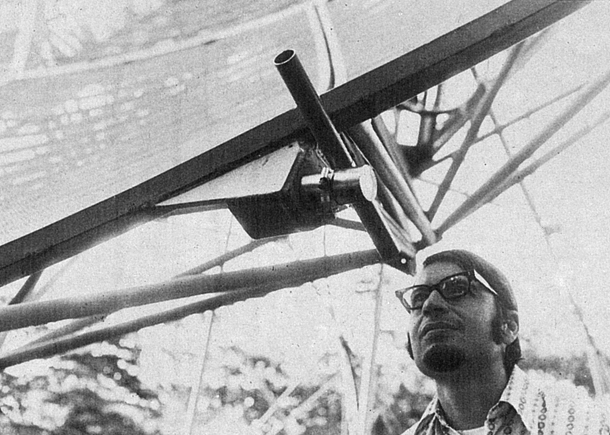
|
A high-gain antenna must be accurately aimed. With this dish the
half-power beamwidth is 6°, about one click on a conventional rotator
control. Al’s indicators read to within 1°. |
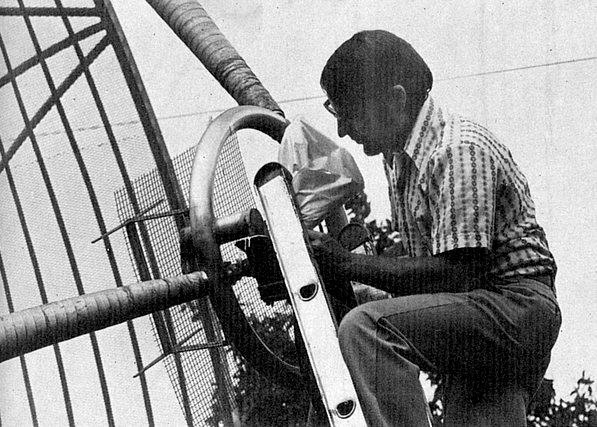 Al attributes the success of his installation to the linear feed
that can be peaked rotating in the plane of the mesh reflector.
(WA2LTM photo)
Al attributes the success of his installation to the linear feed
that can be peaked rotating in the plane of the mesh reflector.
(WA2LTM photo) |
|
VHFer
We said that Al is a
vhfer, implying other phases of activity besides EME. Indeed, he does do
other things in this world. On the same weekend as the Worked All
Continents accomplishment he was at Trenton State participating in the
antenna measuring contest. A loop Yagi he built for 1296 MHz measured more
than 19 dB of gain. At the top of his 100-foot tower is an array of 16x 8
element Yagis for 432 MHz tropo. That has helped to bring his states total
for that band to 34. Another vhf interest is the OSCAR program, mode B, of
course, since it uses his favorite 432 MHz frequency for input.
Vhfers have varying
ideas about de fining a valid contact. because of the inherent weak signal
work. He feels that an assertive policy is needed and looks back at the
early meteor scatter days. Much was written about calls heard one way on a
given; day and portions of calls were heard the other way on another day.
After several days of such partials, could it be considered a complete
contact?
He, as most other
moonbouncers, accepts the definition as an exchange of some unknown piece
of information. They frequently use the T M O 5 system. After call signs
have been established, the signal report, using one of those four
characters, is sent at 3-4 words per minute as the unknown piece of
information. The lowest report is T, indicating that something is there,
like an SØ, M is the minimal report for copy of calls, and information,
with an O there is some margin and long pieces of copy, and 5 can be used
with an actual S report.
Amateur Existence -
Cooperation
The most major amateur
cooperative effort that Allen has been a part of to date has been the
HK1TL operation that made possible his 432 MHz WAC. Every month he
publishes an EME newsletter sent to all known, participants around the
world. As the plans developed he helped to coordinate the scheduling, for
otherwise the bottom end of 432 MHz might have sounded like a 20-meter
pileup.
It was a logistical
achievement for international relations and technology. Amateurs,
officials and relatives in both the United States and Colombia volunteered
countless amounts of time, skill and money to make the expedition a
success.
After missing K2UYH on
the first attempt, the crew at the beachside location near Barranquilla
physically held the huge portable antenna array to keep the sharp antenna
corrected for windage and enable the first 432 MHz and moonbounce Worked
All Continents to be done. The full details of the Pack Rats’ moonbounce
expedition, however, is a story in itself.
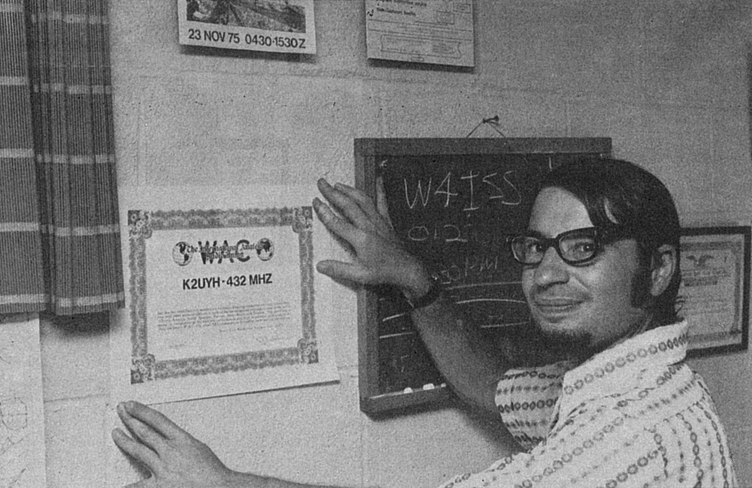 Al posts the certificate he achieved for the first Worked All
Continents on a band above six meters. It truly represents the
International Amateur Radio Union’s goal of promoting technical and
operating performance through worldwide cooperation.
Al posts the certificate he achieved for the first Worked All
Continents on a band above six meters. It truly represents the
International Amateur Radio Union’s goal of promoting technical and
operating performance through worldwide cooperation.
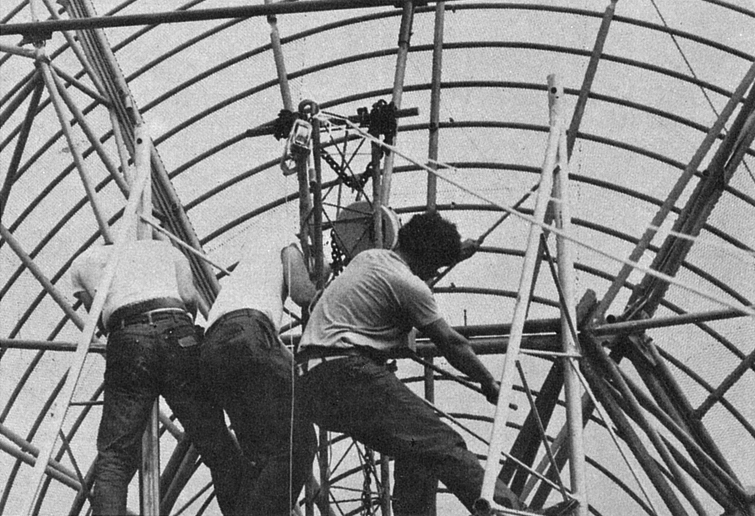 It is more than a one-man show. Constructing such a large device
requires the. cooperative effort of several fellow amateurs.
It is more than a one-man show. Constructing such a large device
requires the. cooperative effort of several fellow amateurs.
|
Futurist
Another classification
we gave Al was that of futurist. For a pastime outside of amateur radio
(!) he is a computer hobbyist. Microprocessor technology has advanced
geometrically in the last few years to bring systems within reach of
interested persons. Quite naturally radio amateurs have become attracted
to the processes and applications, such as controlling the aiming for an
EME antenna. Right now, he says, the computer hobbyist is like the early
radio listener. He has a device that is a novelty, but in a transition
period, he becomes, known as a hobbyist separate from the object. With
some amateurs, like himself, the computer is still an adjunct to his
primary interest of amateur radio. For others, like his friend, Doug
Moser, WA2LTM, the involvement with microprocessors almost overtakes it.
Al’s system is still up at his office, separate from his station.
At Trenton State
College, the program that he oversees is a bit different from a
traditional engineering curriculum. He has placed emphasis on courses that
will attract and involve persons like a typical ham. Because of amateur
radio, someone may feel that the logical step would be an electrical
engineering course, but is.. turned off by the theory and lack of
laboratory classes available. As every ham knows by Murphy’s Law, theory
and practice can be quite far apart. Thus, all classroom courses are
matched as closely as possible to practical experience.
The other integration that he foresees is the reciprocal - technical and
theoretical people into amateur radio. He views the proposed Communicator
class type of license as an ideal way to attract those who are oriented
along amateur lines, but do not want the code.
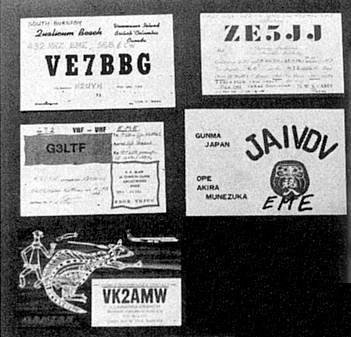 |
Progress toward a 432-MHz Worked All Continents by
moonbounce: In his home continent of North America, Al was inspired to
resume activity by the work of Cor Maas, VE7BBG. This card confirms a
contact between them on November 12, 1973. Almost a month earlier, on
October 13, he worked G3LTF for Europe. Until the HK1TL expedition P. K.
Blair was the only other operator besides Al to have accumulated five
continents. After the 28-foot dish was installed, one of the first
contacts was with the Wireless Institute of Australia station at Illawara,
VK2AMW. That contact of March 10, 1973, set a 432-MHz distance record of
more than 10,000 miles and stood for over a year-and-a half. Only G3LTF
had also worked the sole African representative, Peter Carey, ZE5JJ. Their
two-way was done on April 5, 1974, after a year of fruitless scheduling.
More stations, however, should be successful when Pete puts a 32-foot dish
into operation this fall. Among the stronger signals out of Asia is Aki
Munezuka, JA1VDV. He used a K2RlW-style 20-foot dish for their contact of
March 27, 1975. No card was available at press time for Al’s historic
contact with the last continent in the International Amateur Radio Union,
South America. On July 29, 1976, however, HK1TL completed two-way
communication with K2UYH for the first 432-MHz Worked All Continents.
Another FCC proposal
that he has thoughts about is the bandwidth docket. In his primary band of
420-450 MHz much antagonism has arisen between users of wide-band
fast-scan television and narrow-band weak-signal operators, like EMEers,
over a band plan and value judgments of the different modes. Docket 20777
would eliminate fast-scan television from that band, but Al favors the
League’s, counterproposal of placing ATV on fixed channels for five years,
then reevaluating the situation. Having worked both sides as an operator,
he sees viable development of each in the spirit of amateur radio. With a
workable band plan, he feels, all amateurs’ specialties can continue to
coexist through their unique ability to self-policing and cooperation.
Epilogue
Signals from WB5LUA are
peaked and the message goes across, “ANT WKS FB AL 73.”
What next? Worked All
States is a definite possibility and perhaps DX Century Club. Already, 14
countries are in the K2UYH log.
Of her husband, Sally
Katz says. “Some women marry for money and goods, but he is the only one
who can give me the earth, moon and stars.”
References
1 Katz, “UHF Roundup,” The VHF Amateur August, 1963.
2 Katz, “Simple
Parabolic Antenna Design", CQ, August, 1966.
QST September 1976
Tiera
Luna para Colombia [1976]
Moonbounce work demands that all gear
operate perfectly. This holds even more so when the operation is a
portable expedition to another continent. The Pack Rats did it!
By James
M. Morris KH6HQG
Pelicans swoop the
shoreline as twilight approaches. An environmental engineer, a pharmacist,
a motorcycle mechanic, and others occupy a beach house. They could be
enjoying a cool drink after another warm summer day at the resort.
Instead, they are celebrating, with their own special brew, the success of
an effort that brought them together in that isolated spot the first
moon-bounce expedition to South America - HK1TL.
Last month we
reported that. Allen Katz, K2UYH, completed the first Worked All
Continents on 432 MHz and moon bounce by working that last continent, so
obviously another station had to be on the other end of the two-way
circuit. It was the Mt. Airy VHF Club, of which Al is a member, that
mounted the expedition to provide South America's first 432 operation.
From the club‘s home in Philadelphia, Pennsylvania, five of the club ‘s 82
members journeyed to Barranquilla, Colombia, for successful contact with
16 different EME (earth-moon-earth) stations and approximately 75 OSCAR
Mode B stations, as well as to make new ties and stimulate amateur radio
interest with the people there. Individuals and organizations in both the
United States and Colombia contributed vast quantities of time and funds
to make the operation a success.
In 1956, a group of
Philadelphia amateurs organized to actively promote serious vhf/uhf work.
To characterize their aversion to commercially built equipment they
adopted the nickname of “Pack Rats.” Instead they always favor
experimentation with home-built gear. An inspection of any member’s garage
or shack will reveal a wealth of parts and surplus gear acquired by
trading. Over the ensuing years they have designed, and built converters,
receivers, transmitters, amplifiers and antennas for virtually all amateur
vhf bands.
Their activity takes different forms. During the ARRL January VHF Sweep
stakes plus the June and September QSO Parties, they put their latest
creations to the real test. Consistently, they have topped the
competition. Any active club, of course, operates a net. The Pack Rats
have not one, but five nets every Monday evening on all bands from 50 MHz
through 1296 MHz and the ATVers (amateur television) con duct yet another
net on Friday nights. Their real pride and joy, however, is the W3CCX/3
moonbounce system located in Revere, about 25 miles north of Philadelphia.
On the farm owned by Pack Rat member Walt Bohlman, K3BPP, the club station
is one of the most successful on the air, particularly after the addition
of a 20-foot stressed parabolic dish in the 1972-73 winter. Alter they
made their first complete contact with the Stanford Research Institute
group, WA6LET, they celebrated with a cup of Red Zinger tea, a Pack Rat
success trademark ever since. At the monthly meetings a report would be
given about the latest activity. More and more new stations were noted
from various states, countries and continents - except South America.
Opportunity!
Early this year, a
Colombian amateur, Bolhmar Aguilar, HK1AMW, moved into the same
neighborhood as Elliott Weisman, K3JJZ, a director for the Mt. Airy VHF
Club. Naturally, Bolhmar noticed the vhf antennas. Al though his primary
interest was high frequency, a classic ham chat followed, sparking the
idea of operating moon-bounce on his relative’s property back in Colombia.
The idea was discussed with Bolhmar’s brother in Baltimore, Maryland,
Socrates Martinez, HK1CWB/WB3AFY, and “they thought it would be a great
thing for the country.”
Immediately, Elliott presented the Colombians’
operating site offer to the club’s board of directors. They liked it and
appointed him as coordinator. The red tape began. To make an official
request from the Colombian government, all correspondence must be on
official paper carrying a tax stamp. Price from the consulate: $2 per
sheet. Be sides designing the request letter to detail all the operating
and technical requirements, an additional task was to translate it into
Spanish.
Several letter exchanges followed and to avoid paying duties upon entry, a
list of the equipment had to be provided. Back to the consulate for more
paper. A problem arose because they were still in the process of
assembling the station. Obviously, a whole new station had to be put
together since they wanted W3CCX to work the expedition. That was
resolved.
Soon after the work started, the planning committee became aware that
another coordinator would be needed in Colombia, so Socrates suggested Dr.
Atenogenes Blanco, HK1BYM. He enlisted the aid of the Barranquffla Area 2
Radio Club who later provided invaluable service to the expedition.
Logistics and Red Tape
“We gave the guys building
the stuff the outside dimensions and told them, ‘that’s how big you can
make the thing." Once more the Pack Rat philosophy prevailed. Tony Souza,
W3HMU, built a complete 432-MHz kilowatt amplifier from scrounged parts,
save for a $1.25 part. Even the 8938 final tube came from the endless junk
box. Other primary pieces of equipment that were produced specially for
the expedition included a power supply by Bill Olson, W3HQT, and the
exciter by Walt Bohlman. That used a 4X150 to a 4CX250 driver.
The most outstanding
engineering feat had to be the antenna. Their 20- foot dish could not very
well be taken down or even duplicated for air freight shipment. Instead,
Walt, who designs antennas by profession, devised a system using 16,
K2RIW-style 13-element Yagis so that everything could fit into six-foot
crates. Besides the necessary azimuth and elevation rotation, the antenna
had a third axis for polarization compensation.
Indeed, the moon itself had
a large influence on the actual scheduling. Between perigee and apogee
each month the path loss for the EME path varies by 2 dB - enough to mask
a signal or bring it out of the noise. Other factors to consider were
proximity to the sun and optimum window time for the other stations around
the world. Cor Maas, VE7BBG, coordinated those schedules. Only after those
considerations could they think about their convenience. They selected the
last weekend in July. More logistics problems crept in during the
meantime. Shortly before the scheduled departure for the main group,
Socrates’ XYL, Rose Alva Martinez, went home to Colombia early to purchase
the airline tickets. Although Aerocondor had given a discount, inflation
crept in. Sheila Nassar, HK1CWD, however, made up the difference. The
customs paperwork had not been entirely settled, so Dr. Blanco made a trip
to Bogota, capital of the country, for further negotiations.
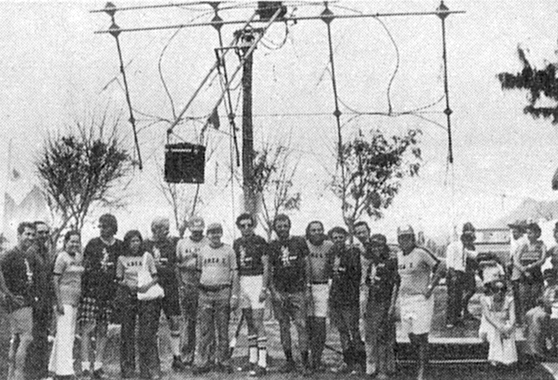
|
The Pack Rats
moonbounce team gather with their Area 2 Radio Club hosts
underneath the 208-element antenna for 432 MHz. It actually
measured one dB of gain better than their 20- foot dish at the
home station in Revere, PA. |
|
To Colombia
At last, all was loaded
for the trip down. At Miami International another friend stepped into
the picture. Russ Wicker, W4ZXI and a fellow moon-bouncer, works there
and made arrangements for the equipment to get on the same flight as the
crew. All
did travel on the same flight. A couple of boxes had some damage, but
that was the least of their worries. After two-and-one-half hours with
customs officials, the gear was cleared only after Dr. Blanco posted a
$3000 bond assuring that all the equipment would be removed from the
country after the specified stay.
Many of the crew had been working with the
Atlantic Division convention to give a seminar on July 25, the same day
of their departure When they did arrive in Barranquilla the following
day, they had a long press conference with the local media. The actual
site was located in the town of Santa Veronica, about an hour-and-a-half
ride from Barranquilla, with the local civil defense providing a truck
and driver for the 1368 pounds of equipment plus crew.
On the Air
On Tuesday, July 27, they
set up the 20-meter link and the first message from W3KKN, their liaison
back home, was that they had received permission from AMSAT to operate
Mode B on Wednesday. Originally, they had not planned to take any OSCAR
gear, but the organization had been alerted and provided the gear.
The first OSCAR and Mode
B contacts were made that Wednesday while setting up the moonbounce
station. At last the big day, July 29, came. “When we patched everything
together and plugged it in the first time - it worked!” Bill Olson said
of that first day. At near-vertical elevations the antenna had
wind-loading problems and the first schedule with K2UYH was missed as
was the one with F9FT. Finally, during the 1800 UTC schedule a two-way
was completed with K2UYH followed by W3CCX.
Another conference was
held that evening with the Area 2 Radio Club, potential amateurs and
c.d. officials. The Pack Rats showed Ham’s Wide World, slides of their
outings and gave more talks until midnight. Then, the hosts celebrated
past 2 AM. Nevertheless, the crew made the hour-and-a-half trip back to
Santa Veronica for a couple of hours sleep before a 6 A.M. OSCAR pass.
Most of the following
days were like that - 12 hours or more of moon schedules and OSCAR
passes. A constant problem, however, was power failure. The first major
occurrence was Friday afternoon from 2:30 P.M. until 6 P.M. because
trees were being trimmed. After it was restored, the voltage measured
only 95 volts forcing cancellation of almost all schedules that day.
During the remaining days that weekend, power fluctuation continued to
be a problem. But always, the Area 2 Radio Club would set out to find
the source of the problem and more than once brought in emergency
generators. Enough power was usually available to operate the 20-meter
liaison. That was one of the prime factors that allowed successful
rescheduling over the weekend. Ernie Kenas, W3KKN and his XYL, Bertha,
W3TMP, provided that link every day of the operation.
Reflections
All the way through,
cooperation and coordination allowed everything to work out. Among those
who helped defray the approximately $9000 in expenses were Collins
Radio, Mt. Airy VHF Club, Northern California DX Foundation and an
anonymous Pack Rat member. Another less apparent, but very important
person was Rose Alva Martinez who did all the cooking for the crew
during their nine-day stay. Before departing, both the Mt. Airy VHF Club
and the Barranquilla Area 2 Radio Club reached a mutual understanding
that they would not lose contact with each other after the project was
over. Of
course, it would have been unrealistic to expect all to have go
perfectly. But, as Weisman said, “It was probably better that we had the
problems because I don’t think that would have had as close a
relationship with the people down there as if we didn’t have any
problems.” Thus, radio amateurs have once again demonstrated that their
unique form of international goodwill can cross all boundaries to create
a common success. QST
October 1976
for OK2KKW web rewrote and edited
Matej,
OK1TEH in year 2008 |